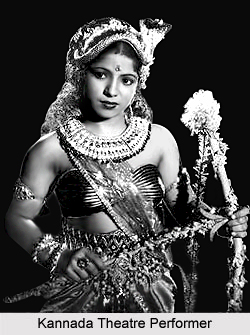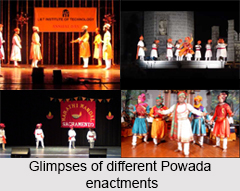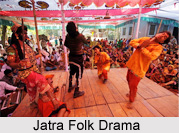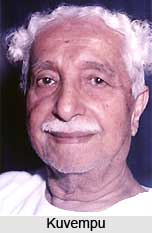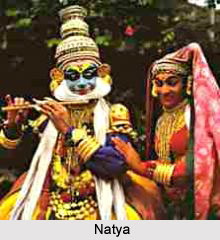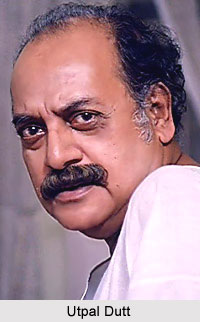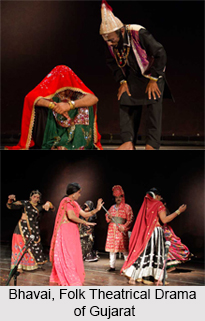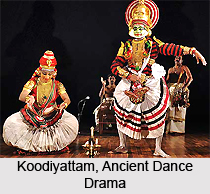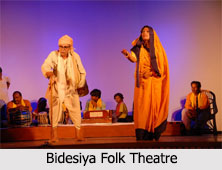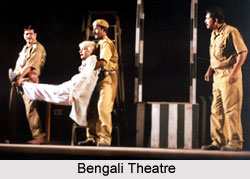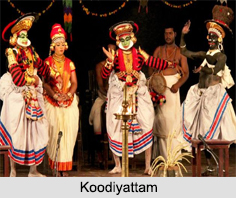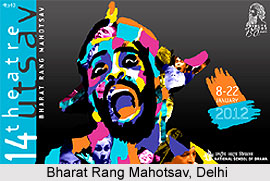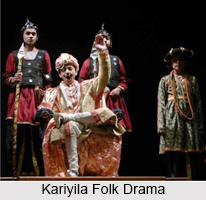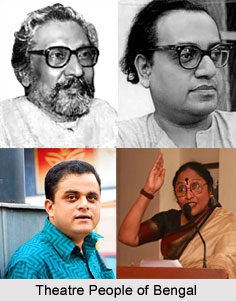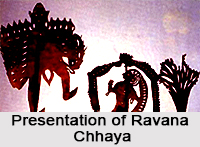 Presentation of Ravana Chhaya involves a number of established procedures which must be adhered to during every show. Before the play begins a coconut is broken in two and a puja is performed invoking the blessings of Lord Rama and Lord Ganesha. Then the leader, who is also the chief narrator, comes out and stands right of the stage in full view of the audience holding a Khanjani in his hands. He then prays to Rama in a Sanskrit sloka, which is followed by an impromptu prose introduction to the episodes to be presented for that particular performance. He then plays a sort of percussive preliminary on his Khanjani.
Presentation of Ravana Chhaya involves a number of established procedures which must be adhered to during every show. Before the play begins a coconut is broken in two and a puja is performed invoking the blessings of Lord Rama and Lord Ganesha. Then the leader, who is also the chief narrator, comes out and stands right of the stage in full view of the audience holding a Khanjani in his hands. He then prays to Rama in a Sanskrit sloka, which is followed by an impromptu prose introduction to the episodes to be presented for that particular performance. He then plays a sort of percussive preliminary on his Khanjani.
Following all these rituals, the actual performance commences. After all the preliminaries are over, two stock characters appear on the screen- the village barber and his grandson. The puppets are very small, about 6 inches in height. The narrator in impromptu prose speaks the dialogue for both characters. The dialogue is humorous and leads to the episode of the birth of Rama in Ayodhya, The relevant lyric from the Vichitra Ramayana is then sung. In singing, the chief narrator is assisted by one or two vocalists, usually from behind the screen. The vocalists also play on the Daskathi, a type of castanet, and a pair of small cymbals, called Gini.
There are 3 puppeteers behind the screen. They squat on the ground and manipulate the puppets according to the demands of the prose, dialogue and the text of the songs. The shadows of the manipulators do not fall on the screen since a mat, made of a type of locally grown straw, is stretched between the screen and ground. The episodic structure of the play follows the same sequence as the serialised lyrics of Vichitra Ramayana, The leader links one lyric to the next by prose or recitative verse passages. These linking passages are entirely in the oral tradition.
The manipulation of the puppets is by far the most important part of the performance of the Ravana Chhaya. The highly stylized puppet figures have no jointed limbs. A sort of vertical jigging of the puppets from side to side and towards or away from the screen characterizes the manipulation. At times the puppets are revolved round on their axis as they are faded in or out. There is no dramatic gesticulation by the puppets since they have no jointed limbs. The art of manipulation lies in creating a suggestive pose by the puppet expressive of the character and its relationship to similarly posed characters and settings. The settings are created by bringing onto the screen pieces representing houses, trees, chariots, mountains, etc. Thus the performance acquires the quality of an animated illustration of a musically narrated theme.
Apparently the technique of manipulation in Ravana Chhaya shadow-play looks very simple but there are subtleties of the back-stage manipulation which may escape the notice of a casual onlooker. Puppets have to be stylized, more or less, such that in their movements they should not exactly imitate human beings. This is done so that they retain their own fascinating `identity`. Of all puppets, shadow-puppets are the most stylized, but in some of the forms of shadow-play like that of Andhra Pradesh or Karnataka, the puppets having many joints, are more articulate. The manipulation of these puppets requires as much dexterity as sensitivity.
In the case of Ravana Chhaya, where the puppets have no jointed limbs, the art of their manipulation requires much more sensitivity than dexterity. To suggest that a puppet is walking or fighting when it has no jointed legs or hands, indeed calls for great sensitivity since too much jigging is likely to make the movement ridiculous yet too little may make it dull. Ravana Chhaya puppeteers with only jigging, tilting, fading the puppets in and out, suggest all possible movements and dramatic action. Those who only want gimmicks from the puppets may, therefore, feel bored with a Ravana Chhaya show. To appreciate the lyrical aspect of the Ravana Chhaya shadows, their solid graphic quality, high degree of stylization and subtle suggestiveness, one has to have the right sensitivity as well as sensibility.
At times Ravana Chhaya shadow-show acquires a poetic quality, similar to `modern poetry`. For instance, when Lord Hanuman gets ready to cross the sea to Lanka, the smaller figure is substituted by the larger one suggesting that he has expanded himself physically. When he takes the leap, the puppet figure that remained almost pressed to the screen, is moved to a distance from it, throwing a diffused but highly fascinating shadow that flashes out of the screen like an extremely swift monsoon cloud. Other such instances from the show would be Hanuman uprooting the trees of Madhuban, Indrajit dispatching his deadly naga-pasha across the sky, the magnificent Ravana fighting with Rama and the fascinating shadow-arrows flashing across the screen like dark-lightning and so on.







